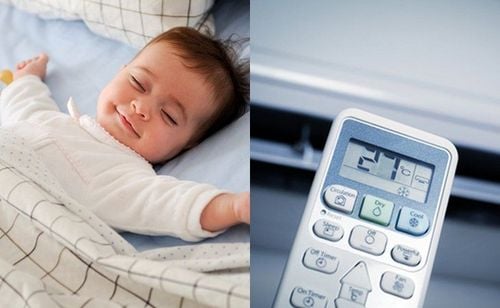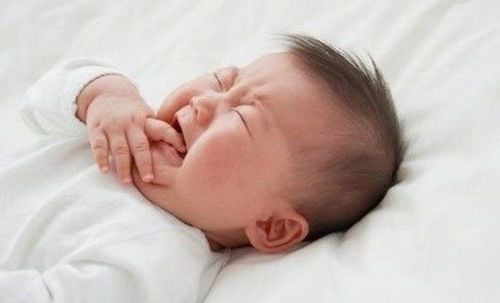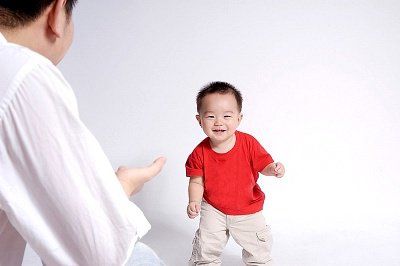This is an automatically translated article.
Children, especially toddlers, can experience a number of sleep disorders like parasomnias, sleep apnea, and narcolepsy. These sleep disorders can affect a child's health and development, both physically and mentally. Therefore, early detection for remedial action is extremely important.1. Normal sleep in children
Infant sleep is quite different from adult sleep. Up to 50% of sleep in infants under 6 months of age is rapid eye movement (REM) sleep, while this sleep in adults is only 20%.Infants enter sleep through an initial phase of active REM, as opposed to adults who usually do not enter REM sleep until 90 minutes into the sleep cycle. REM sleep occurs more often in the sleep cycle in infants, so babies have shorter sleep cycles than adults.
Quiet REM sleep in infants under 6 months of age is also known as undivided 4 EEG stages in the known adult sleep pattern.
Children from 6 months old have a sleep structure similar to that of adults. The initial settling-in period usually takes 10 to 20 minutes, after which the baby will move from stage 1 no REM sleep (NREM) to stage 3 or 4 of sleep. Babies can go back to stage 1 and a new sleep cycle. After one to two cycles of NREM sleep, the REM phase will last about 60 - 90 minutes.
In infants, the amount of sleep is divided equally between night and day. Nighttime sleep is gradually increased during the first year to a single uninterrupted block of time. Meanwhile, daytime sleep gradually decreased during the first 3 years. Children up to 4 years old, almost no longer require a nap. The need for sleep at night also decreases, by adolescence, the need for sleep of children is similar to the needs of adults.
2. Sleep disorders in children
Common sleep problems in children include:Pseudo-insomnias (Parasomnias): agoraphobia, delirium, and bedwetting. The condition appears to be related to central nervous system immaturity and is often overgrown. Obstructive sleep apnea syndrome (OSAS) is often missed in children and can often be cured through surgery. Narcolepsy. The frequency of nocturnal awakenings in infants is 100%, decreasing to about 20-30% in 6-month-old infants. Sleeping through the night without waking is something that a child cannot always maintain once achieved. Children who have previously slept through the night may occasionally wake during the night often due to social factors. About one-quarter to one-third of babies will continue to wake at night and need parental intervention to get back to sleep.
2.1. Parasomnias Pseudo-insomnias (Parasomnias) is a sleep disorder characterized by abnormal polymorphisms. They occur intermittently, often due to the immaturity of the central nervous system. So the condition is more common in children than adults and usually develops more quickly over time.
According to some experts, these disorders are paroxysmal, predictable before they appear in the sleep cycle, unresponsive to environmental stimuli, and characterized by retrograde amnesia. The diagnosis is usually made through a thorough examination of the patient, rarely requiring laboratory tests.
2.1.1. Night terrors Night terrors usually occur about 90 minutes after falling asleep, during stage 3 or 4, NREM. The child suddenly sits up straight and screams, which parents can't calm down for 30 minutes before the baby relaxes and falls back to sleep. The child may now be able to have rapid breathing, tachycardia, and other obvious signs of autonomic arousal.
Night terrors usually occur in children aged 3 - 8 years. This condition needs to be differentiated from nightmares that children experience while sleeping. Night terrors are more likely to occur during times of stress or fatigue.
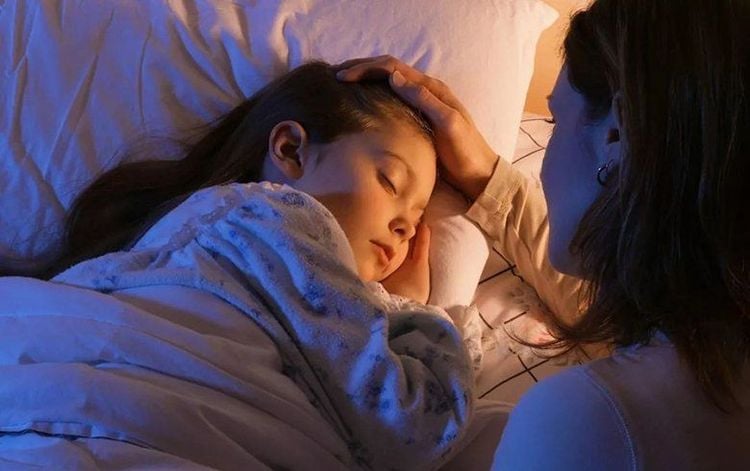
Chứng hoảng sợ ban đêm thường xảy ra ở trẻ em từ 3 - 8 tuổi
Reassure the child. Reduce stress that may occur in the child's living environment. Make sure your child gets enough rest. For children who experience uncontrollable or disruptive night terrors, then Diazepam can be used, which has been used with some success.
2.1.2. Sleepwalking and lethargy Sleepwalking is a condition in which a child sits up in bed with his eyes open but can't really see anything. The child may feel restless, move in bed, or be able to walk around the house.
Delirium, also known as delirium, is a condition in which a child utters mumbling and stuttering, intelligible speech during sleep.
These disorders are more common in school-age children, are more common in boys than girls, and are often associated with bedwetting. Children with sleepwalking have potential dangers to the body such as falling from a balcony or falling down the stairs. Parents can avoid these situations by:
Design a bedroom for the child on the first floor of the house. Windows and doors must have sturdy fixed frames. When detecting children sleepwalking, parents need to try to intervene to a minimum. Do not shake, slap or yell at the child. These behaviors often develop more rapidly in adolescence and they generally don't require any other intervention.
One intervention that proved effective in one study was scheduled wake-ups. Parents need to keep a diary of sleepwalking for several nights and then start waking the child about 15 minutes before sleepwalking occurs and make sure the child is fully awake for at least 5 minutes. This measure has helped more than 80% of children get rid of sleepwalking
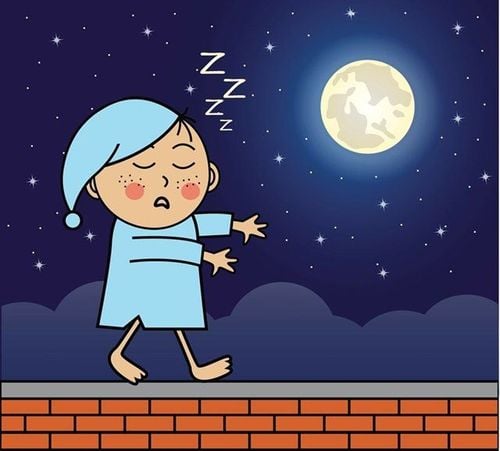
Chứng mộng du là tình trạng một đứa trẻ ngồi dậy trên giường với đôi mắt mở nhưng thực sự trẻ không nhìn thấy gì
Primary bedwetting is the child never being dry all night. Secondary bedwetting is when a child's bedwetting returns after a year without the condition. Of these, primary bedwetting is more common and is less likely to have a medical cause. The etiology of primary bedwetting can be due to many factors such as:
Family history of bedwetting Children with growth retardation between the ages of 1 and 3 are more likely to have bedwetting until 6 years of age. year old. Children with bedwetting were found to have poorer bladder function, which means less urine volume that the bladder can hold. although their capacity is not different from that of children without bedwetting. Bedwetting is considered by most sleep researchers to be senile insomnia because it occurs only during NREM sleep.
Measures parents can apply to help improve bedwetting in children are:
Limit liquid intake in the evening. Wake the child to the toilet before the parent goes to bed. Bed wet alarm.
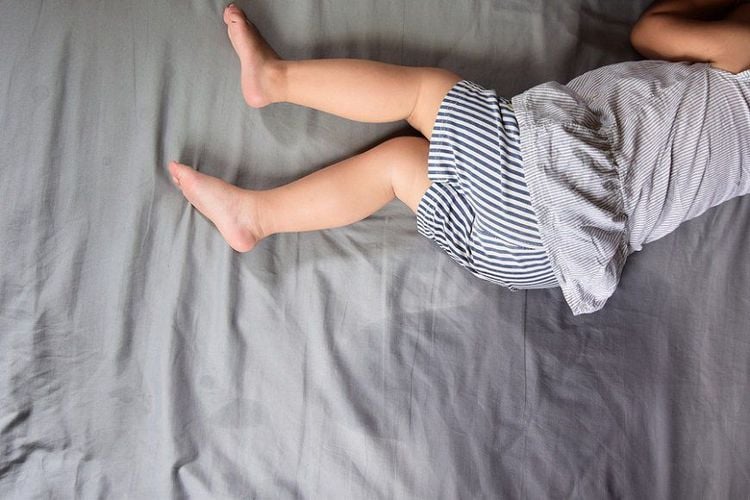
Đái dầm ban đêm hay thường được gọi ngắn gọn là đái dầm là một trong những chứng mất ngủ giả phổ biến và dai dẳng ở trẻ em
Snoring Difficulty breathing while sleeping Mouth breathing while sleeping Parents can have trouble feeding their baby Obstructive sleep apnea in children is often caused by enlarged tonsils out. Other causes include:
Craniofacial abnormalities Obesity Neuromuscular diseases Allergic diseases Adults with sleep apnea due to airway obstruction are often intermittent and often deeper. In children, where the cause is enlarged tonsils, the obstruction is more persistent and often less profound. Children with sleep apnea often have learning or behavioral difficulties including attention deficit or hyperactivity disorder.
The diagnosis of obstructive sleep apnea was made in a pediatric sleep laboratory using nocturnal oximetry and multiple imaging.
Most children with obstructive sleep apnea experience significant remission after tonsillectomy and VA. Children with OSAS from other causes will not benefit from tonsillectomy and VA. In these cases, continuous positive nasal airway pressure (CPAP) can be used, which is safe and effective in children.
2.3. Narcolepsy Narcolepsy is not common in children, but can sometimes occur in adolescence. The main symptoms of this disease are:
Excessive daytime sleepiness. Children do not experience hallucinations or sudden loss of muscle tone as often as adults. Initially, children with narcolepsy find it difficult to wake up in the morning. When awakened, the child may appear confused or excited, sometimes swearing. Somnolence can be difficult to diagnose, requiring a variety of factors to be evaluated if suspected. These children may be able to improve their condition through regularly scheduled naps. Children may also need to use stimulants.
This is a lifelong illness with significant morbidity, so children with narcolepsy should be monitored by a sleep specialist.
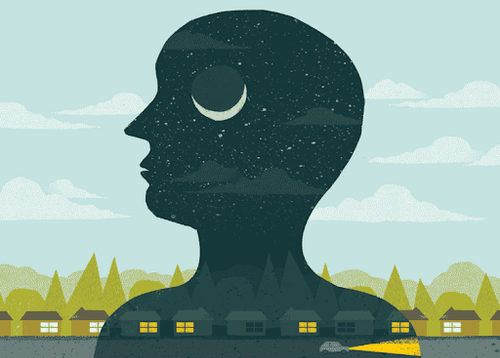
Chứng ngủ rũ không phổ biến ở trẻ em, nhưng đôi khi có thể xảy ra ở tuổi vị thành niên
Although up to 95% of babies cry after waking up at night and need parental response before going back to sleep, by the time they are 1 year old, about 60 - 70% of babies are able to alleviate this situation.
A child who is put to bed while awake and learning to comfort himself is usually able to calm himself and go back to sleep when he wakes up at night. On the other hand, a baby who falls asleep with some parental influence such as rocking may have a hard time getting back to sleep when he wakes up alone at night.
For that reason, parents may need to consider stopping rocking to put their baby to sleep, or not allowing their baby to sleep in a place other than their crib. Parents can wait a while before responding when their baby is fussy during the night, to help the baby learn to put himself back to sleep. Gradually, the child will go back to sleep on his own without parental intervention.
3. Children with sleep disorders need to see a doctor when?
Many children have difficulty falling asleep and staying asleep. Your baby's chances of having trouble sleeping are increased if it's your first child, or he's hyperactive or has ear infections.Parents are often more anxious when taking care of their first child and tend to leave the child comfortable, with no rules when it comes to bedtime. Children with ADHD can interfere with sleep. Toddlers with frequent ear infections tend to wake up at night when they feel uncomfortable, which continues while they are in the treatment phase.
In fact, less than 10% of toddlers have a true sleep disorder, defined as a more serious sleep problem rooted in a physiological condition. Jodi Mindell, associate director of the Sleep Disorders Center at Children's Hospital of Philadelphia, asks questions to assess whether a child has a sleep disorder, including:
Does your child snore? Does your child breathe through his or her mouth while sleeping? Does your child often choke or cough at night? Does your child sweat a lot at night? Does your child appear extremely confused when he wakes up in the middle of the night? Does your child kick his feet or bang his head when he falls asleep? Does your toddler just walk and look terrified when he wakes up in the night? Does your child kick their feet in rhythm or get out of bed while sleeping? Does your child sleep well? If your child is correct on any of the above questions, he or she may have a sleep disorder and you should take your child to the doctor to find out what the problem is and how to deal with it. how.
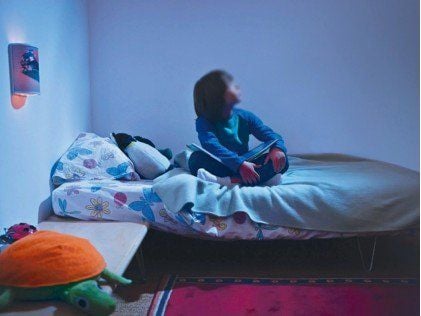
Nhiều trẻ em khó đi vào giấc ngủ và ngủ không sâu giấc
Please dial HOTLINE for more information or register for an appointment HERE. Download MyVinmec app to make appointments faster and to manage your bookings easily.
Reference sources: babycenter.com, aafp.org



